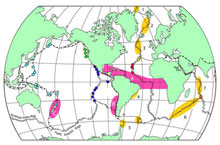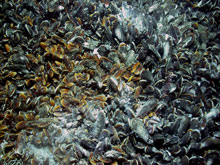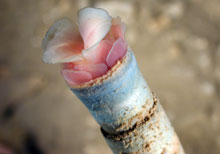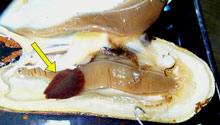A map of the world’s ocean showing target areas for biogeography of chemosynthetic ecosystems research. Area "A" (in pink) includes the Equatorial Atlantic Belt region, extending from the seeps off Costa Rica, through the Gulf of Mexico and Caribbean, and across the Atlantic to western Africa. Click image for larger view and image credit.
One of approximately 120 images used to "stitch" together a large photomosaic of what is unofficially being called the Big Mussel Bed at Atwater Valley 340. The image was taken with the Jason down-looking still camera, about three meters above the sea floor. Click image for larger view and image credit.
Closer Than They Appear
June 14, 2007
Erik Cordes
Harvard University
27° 6.91 N
91° 9.96 W
One of the primary goals of the Expedition to the Deep Slope 2007 expedition is to examine the biodiversity of the seep sites we encounter. This information will, in part, be interpreted along with a number of other previous and ongoing studies of the seeps of the Equatorial Atlantic Belt. This region extends from the Gulf of Mexico through the Caribbean Sea, to the western Atlantic, and across the equator over to the eastern Atlantic off Africa. It includes the seeps of the well-studied upper slope and those we are currently investigating in the Gulf of Mexico, as well as the Blake Ridge off the coast of North Carolina, Trinidad, Barbados, the coast of Brazil, the hydrothermal vents on the equatorial segments of the Mid-Atlantic Ridge, and the seeps off the western coast of Africa, including the Gulf of Guinea and the Angola Margin.
Many of the organisms at these seeps and vents are very closely related; in fact, there are some species that are shared between these sites. The mussels and tubeworms of the Gulf of Mexico are the same species as those at the Blake Ridge and Barbados sites in the western Atlantic, and their closest relatives are at the seeps off of Africa. In addition, there is also a new, undescribed species of Lamellibrachia that we discovered during last year’s cruise (although we didn’t know it at the time!). Its closest known relative is not the other Lamellibrachia species in the Gulf of Mexico, but is the species found in the Mediterranean Sea. In addition, there is one species of polychaete worm that lives inside the shells of the mussels in the Gulf of Mexico, Blake Ridge, and the Mid-Atlantic Ridge. Of course, there is more to seeps that just worms and mussels, and we can compare entire communities found in different places.
A close-up view of one of the undescribed species of Lamellibrachia that scientists discovered during last year’s cruise. Click image for larger view and image credit.
Scientists have found this bright red polychaete worm, Branchiopolynoe seepensis (indicated by the yellow arrow), living in the shells of mussels in the Gulf of Mexico, Blake Ridge, and the Mid-Atlantic Ridge. Click image for larger view and image credit.
So far, we have found that the deeper sites in the Gulf of Mexico are more similar to the Barbados sites at the same depth than they are to Blake Ridge; and that the upper slope sites of the Gulf of Mexico are more similar to the shallower sites off of Barbados than they are to the deeper sites here in the Gulf. This tells us that depth may be more important than distance in determining what we will find.
But how could these species travel throughout this region, and occasionally get all the way across the Atlantic? This would be easy for a large fish or whale, but not so easy for larvae that cannot even swim against the current, or a tubeworm that is attached to the bottom! These species disperse by having mobile larval stages that float with the currents in the oceans. We are only beginning to learn about how these currents travel around the globe in deep water, but we know it is possible to ride them across the Atlantic, even if this is a rare event. What we still do not know is how long the larvae of the tubeworms and mussels (not to mention all of the other species that we know even less about) could live, or even at what depth they stay in the water column. But just finding these species and determining how similar they are at all of these sites is the first step to solving this puzzle.



































